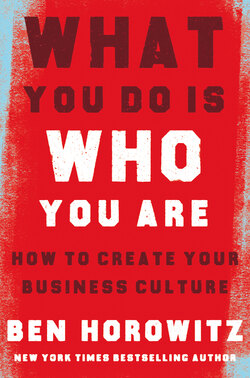Читать книгу What You Do Is Who You Are - Бен Хоровиц, Ben Horowitz - Страница 9
WHAT MAKES A CULTURE WORK?
ОглавлениеCulture clearly has a powerful effect. So how do you shape it, how do you set it deep in people’s minds, and how do you fix it when it goes wrong?
These questions led me to larger questions and a wider frame of reference. How does culture work in a variety of different contexts? What makes it last for more than a few years?
I have long been interested in history, and particularly in how people behaved differently from what I would have expected, given the circumstances they were born into. For instance, I would never have expected that a man who was born into slavery and who would one day free the slaves of Haiti would own slaves himself along the way—but he did. Understanding how historical cultures shaped people’s views led me to begin considering what they had to do to change themselves and their culture. Grasping that seemed to be the key to creating the kind of culture that I wanted.
I selected four models in particular, one of whom is still very much alive. I wasn’t looking for ideal cultural end states—some of the models produced extremely violent or otherwise problematic cultures—but for people who were outstandingly effective in getting the cultures they wanted. Each of these models made me ask giant questions:
Why has there been only one successful slave revolt in human history? And how did Haiti’s Toussaint Louverture reprogram slave culture to orchestrate it?
How did bushido, the code of the samurai, enable the warrior class to rule Japan for seven hundred years and shape modern Japanese culture? What set of cultural virtues empowered them? The samurai called their principles “virtues” rather than “values”; virtues are what you do, while values are merely what you believe. As we’ll see, doing is what matters. (In what follows I will use “virtues” to refer to the ideal, and “values” to refer to what most companies now espouse.) How exactly did the samurai focus their culture on actions?
How did Genghis Khan build the world’s largest empire? He was a total outsider, imprisoned as a youngster by his own tiny nomadic tribe. It’s easy to see how that made him want to smash existing hierarchies. But how, exactly, was he able to create an innovative and inclusive meritocracy? One that enabled him to constantly grow and improve while his foes were standing still?
How did Shaka Senghor, sentenced to nineteen years in a Michigan prison for murder, make his prison gang the tightest, most ferocious group in the yard—and then transform it into something else entirely? How did culture turn him into a killer? How did he rise to dominate that culture? How did he take a group of outcasts and turn them into a cohesive team? Finally, how did he recognize what he disliked about his regime, and, by changing himself, change the entire prison culture?
Companies—just like gangs, armies, and nations—are large organizations that rise or fall because of the daily microbehaviors of the human beings that compose them. But figuring out whether the root cause of a company’s success is its culture or some other factor isn’t easy. Most business books don’t look at culture from a wider, more sociological perspective. And most attempt to dissect successful companies’ cultures after the companies have succeeded. This approach confuses cause and effect. There are plenty of massively successful companies with weak, inconsistent, or even toxic cultures; a desirable product can overcome a miserable environment, at least for a while. If you don’t believe me, read up on Enron.
To avoid survivorship bias—the logical error of concentrating on companies that succeeded and falsely concluding that it was their culture that made them great—I try not to reverse engineer. Instead I look at the cultural techniques that leaders used as they tried to strengthen their culture in specific ways, and show how those efforts played out. So you won’t find any absolute “best cultures” in this book, just techniques to make your own culture do what you want it to.
